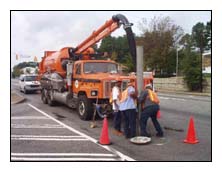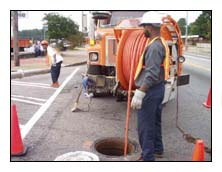Sanitary Sewer Overflows (SSOs)
Beyond the 19-square-mile combined
sewer area, Atlanta's sewers are separated  (85% of the total sewer area). Sanitary wastewater
flows in its own pipe to the treatment facility, and stormwater
flows in a separate pipe to a receiving stream. Like many older
cities, much of Atlanta's sanitary sewer system is aged and
in disrepair. Cracked and leaking pipes, built to handle sanitary
sewage alone, admit groundwater
and storm water as well, increasing the volume of flow in the
pipes. In addition, as a result of Atlanta's growth, the sewers
are receiving sanitary
sewage volumes greater than anticipated when they were originally
constructed. Improper connections at residences and businesses
also allow stormwater to enter the sanitary
system. Consequently, these sanitary sewer systems are strained
beyond their capacity and experience sanitary
sewer overflows.
(85% of the total sewer area). Sanitary wastewater
flows in its own pipe to the treatment facility, and stormwater
flows in a separate pipe to a receiving stream. Like many older
cities, much of Atlanta's sanitary sewer system is aged and
in disrepair. Cracked and leaking pipes, built to handle sanitary
sewage alone, admit groundwater
and storm water as well, increasing the volume of flow in the
pipes. In addition, as a result of Atlanta's growth, the sewers
are receiving sanitary
sewage volumes greater than anticipated when they were originally
constructed. Improper connections at residences and businesses
also allow stormwater to enter the sanitary
system. Consequently, these sanitary sewer systems are strained
beyond their capacity and experience sanitary
sewer overflows.
During SSOs, a mixture of untreated sewage, groundwater and
stormwater overflows from the pipes or from manholes connected
to the pipes. Many sewer lines run alongside creeks and streams,
many of which are adjacent to private property.
In order to address sanitary sewer system improvements, the
City, EPA
and EPD
negotiated a second comprehensive settlement, titled the First
Amended Consent Decree (FACD). The FACD prescribes evaluation
and improvement measures to eliminate SSOs and to protect the
City's investment in upgraded WRCs. The
SSO program includes the development and implementation of Maintenance,
Operations and Management (MOM) programs, completion of the
City's Capital Improvement Program (CIP) for the sewer system,
an aggressive grease management program and the evaluation and
rehabilitation of existing sewers.
Much of the work mandated in the FACD builds on City programs
that are already underway, including:
- SSES,
using closed circuit television cameras to inspect the insides
of the sewers and asses their condition
- capacity
certification programs to intensify review of building
permit applications that propose adding new flows into the
sewer system, and
- management plans to operate the collection system more
effectively,
- fully implemented grease
permitting program.
The long-term goal of the SSO program is to eliminate groundwater
and stormwater entering the system. The project begins with the Sewer System
Evaluation Survey (SSES), a comprehensive evaluation of the
system's condition. The SSES will help identify locations where
major rehabilitation and repairs are needed. The SSES work will
be carried out over 6 to 8 years, and involves 6 sewer groups,
prioritized according to the severity of their condition.
entering the system. The project begins with the Sewer System
Evaluation Survey (SSES), a comprehensive evaluation of the
system's condition. The SSES will help identify locations where
major rehabilitation and repairs are needed. The SSES work will
be carried out over 6 to 8 years, and involves 6 sewer groups,
prioritized according to the severity of their condition.
Some of the signs of a sewer failure are obvious - sinking
or cave-in of a street surface of the ground above the sewer.
The work sequence for determining and addressing less visible
problems is:
- clean the sewers
- install, monitor and analyze data from flow meters
- assess current condition of the sewers with closed circuit
TV
- conduct smoke and dye testing, flow isolation and soil boring,
groundwater monitoring using meters placed at strategic locations
throughout the City
- assess the condition of manholes and manhole covers
- make point repairs where collapse has occurred or is imminent.
Once the needs have been identified, rehabilitation and repair
will be accomplished with trenchless technology (i.e., cured-in-place
pipe or pipe-bursting techniques) wherever possible, to minimize
impact to public and private property.
Capital Improvement Program (CIP)
Atlanta's future will be greatly affected by the City's ability
to maintain affordable, high levels of service for the health
and safety of its citizens. The CIP will upgrade, rehabilitate,
or replace sanitary sewers, as needed, to address sewer overflows
and backups into homes that result from a lack of capacity within
the sanitary and combined sewer systems. Sixteen individual
sewer systems are being addressed by the CIP. The project include
construction of relief sewers, sewer separation, lining of existing
sewers, and construction of new sewer pipes - often with large
diameter than the original pipes, to increase flow capacity.
The FACD deadline to complete the sanitary system repair program
is July 2014. The Mayor has recently committed to achieving
full compliance by 2012, two years early!
|